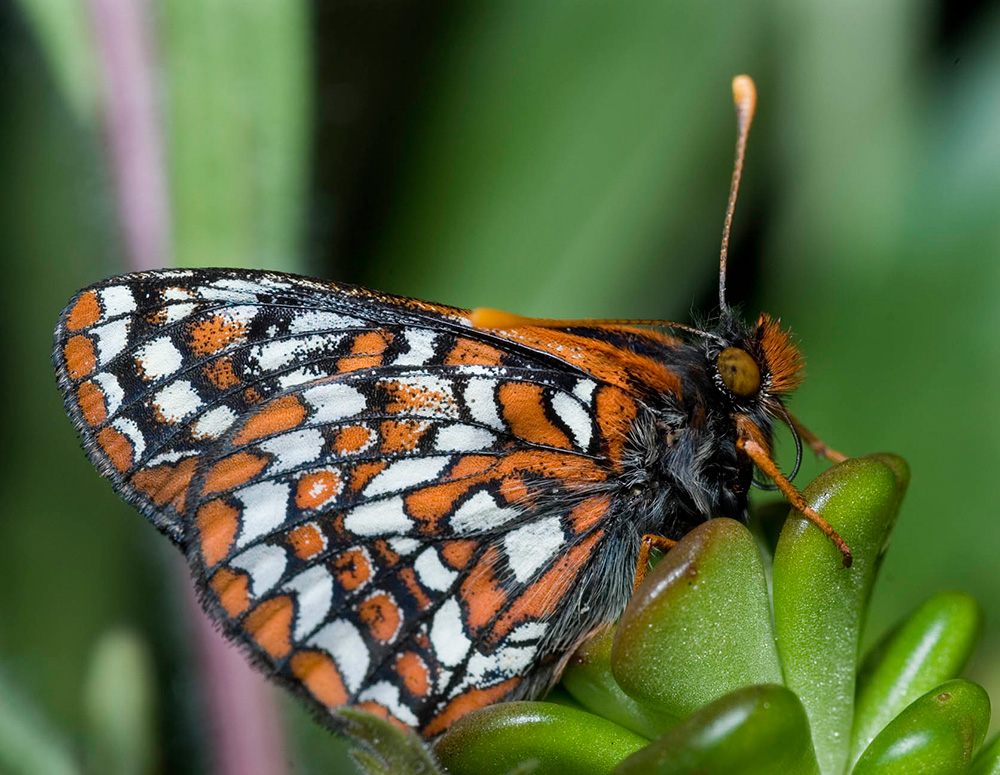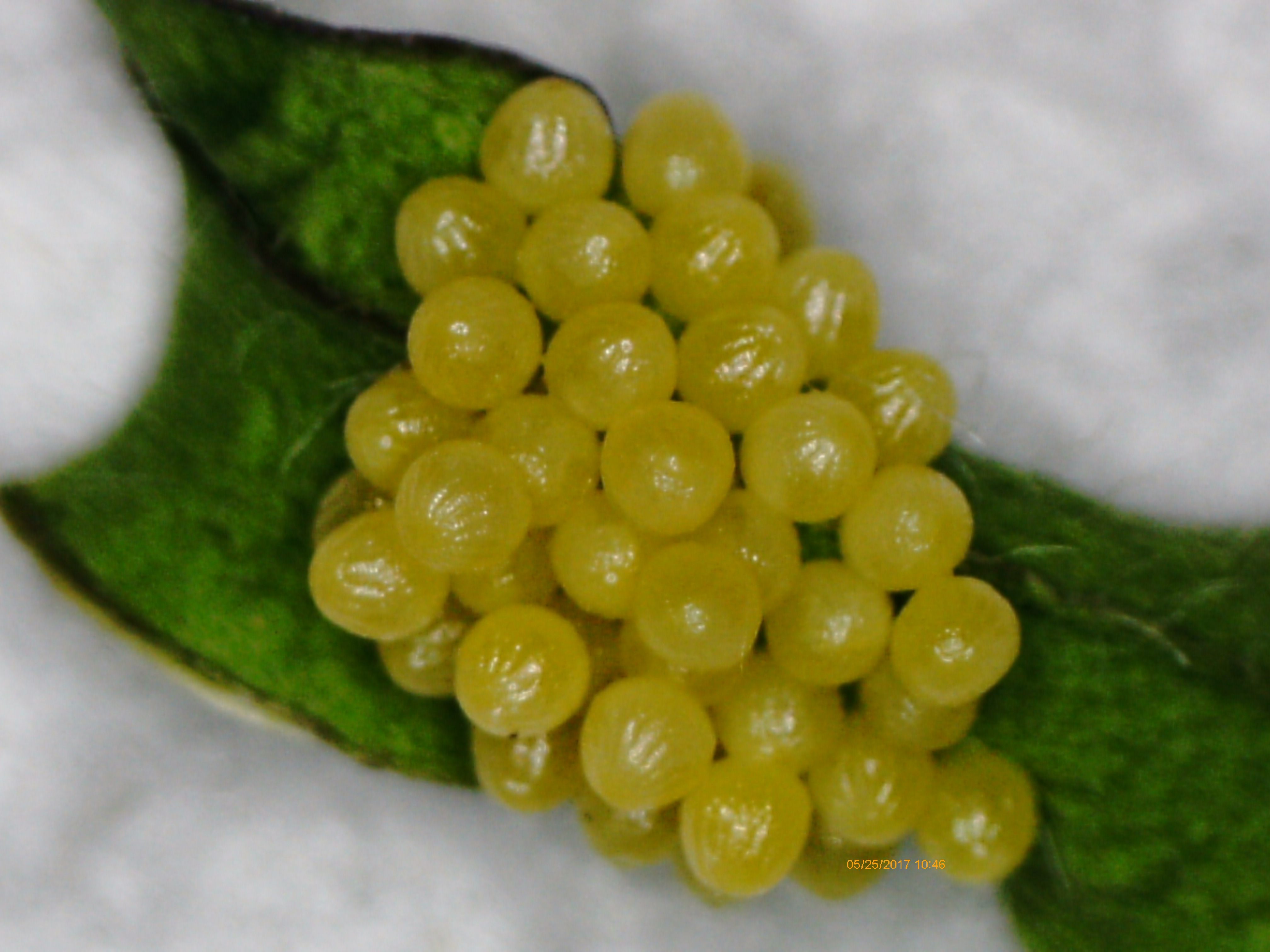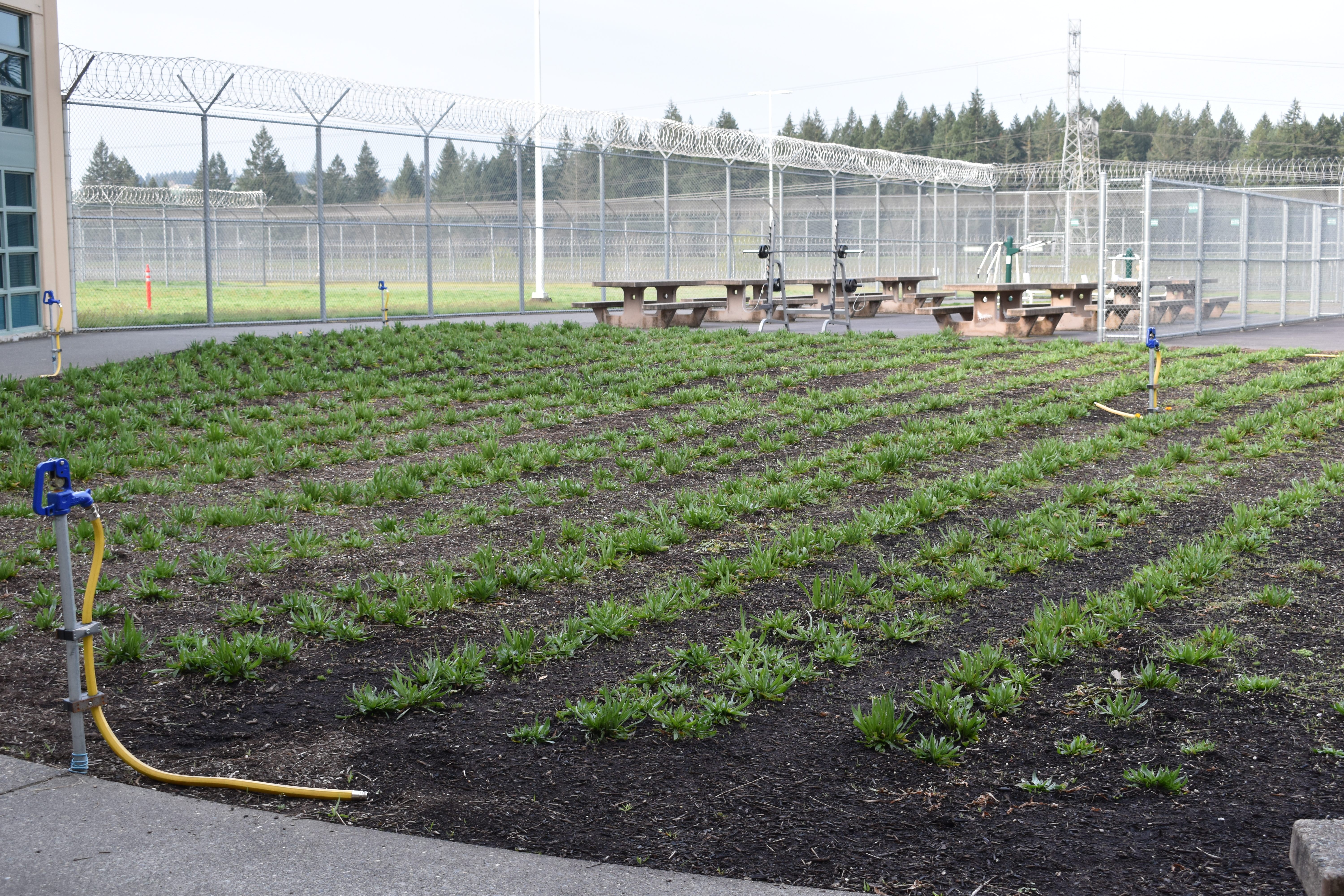A Butterfly Conservation Lab Takes Flight in a Women’s Prison
It’s also helping incarcerated women reconnect with nature.

Carolyn Exum hadn’t touched a plant for almost 20 years. It’s hard to see, much less touch, nature from inside the medium-security correctional facility at Coffee Creek, where Exum is currently incarcerated. For years, no green things grew within the walls of Coffee Creek, Oregon’s only women’s prison. But that’s changed, thanks to a new program that is teaching Exum and others how to rear endangered Taylor’s checkerspot butterflies within the prison itself, giving Exum and others newfound access to nature. Exum, who worked in a garden before her incarceration, almost forgot how much she loved rooting her fingers in dirt and or feeling the soft green veins of a leaf. “There’s life in plants,” she says. “We didn’t have a lot of that before.”
The Taylor’s checkerspot butterfly has stubby, orange-checked wings just longer than two inches. Thanks to agricultural and urban development, the butterfly has now lost 99 percent of its former grassland habitat in the Pacific Northwest. Only two known populations of the Taylor’s checkerspot remain in the wild.
Launched in May 2017, the Coffee Creek butterfly conservation lab is the result of a partnership between the Oregon Zoo, the U.S. Fish and Wildlife Service (USFWS), and the Institute for Applied Ecology, a Corvallis-based nonprofit. In the program’s first year, three incarcerated technicians worked with eggs and larvae, but no butterflies. This March, the program raised 476 caterpillars that were released back into the western plains of Oregon by biologists at the USFWS.

In recent years, organizations such as the Sustainability in Prisons Project have pushed to bring science and conservation programs into correctional facilities. The majority of these take place in minimum-security prisons, where incarcerated people require less-intense security and can be cleared to work off-site for landscaping or gardening, according to Chad Naugle, the sustainability programs manager for the Oregon Department of Corrections. Coffee Creek’s lab is the first of its kind in a medium-security facility.
People in medium- and maximum-security prisons have far less flexibility. Adults are not allowed to cross the gate without two security officers, so all available jobs all take place inside the prison fences—mostly limited to food production, janitorial work, or taking calls for the local Department of Motor Vehicles, Naugle says, as well as in educational programs. Before the conservation lab, Exum worked as one of Coffee Creek’s GED tutors. Sarah Martin, who also now works in the lab, previously worked in the facility’s computer-aided drafting program. “We wanted a more meaningful job opportunity for the adults in custody,” Naugle says. “The chance to work with a live animal and get to help out this endangered species becomes restorative justice and provides self-worth for them.”
Naugle first came up with the idea in 2016 while assembling the department’s sustainability program. He knew the Taylor’s checkerspot was in trouble and reached out to the Oregon Zoo to see if Coffee Creek could help. The zoo, cautious but excited, tasked Coffee Creek with raising and harvesting a batch of viola plants, the only food source for another endangered butterfly, the Oregon silverspot. After the successful propagation of around 100 violas, the zoo agreed to let Naugle open a captive rearing lab—inside the prison. Naugle interviewed and selected four incarcerated women with a history of good behavior and sufficient time left on their sentences so that they could be involved in the program long enough to train others. (Exum and Martin are both currently serving life sentences at Coffee Creek.)

Naugle converted a spare room—formerly used for yoga and emergency bed storage—into a makeshift, climate-controlled lab. Coffee Creek installed a stainless steel industrial sink, humidifier, split-air AC system, water station, tool cage, shadow board for organizing tools, racks, cages, and grow lights. The lab connects to the prison’s housing unit, so the technicians have access in an emergency. Outside, Naugle had a shed built for the checkerspots to use during hibernation.
The Oregon Zoo has a checkerspot rearing lab of its own, but they’re not quite the same. Coffee Creek’s must adhere to certain standards. For example, the technicians are only allowed to use soft-point scissors, says Ronda Naseth, a butterfly conservationist at the Oregon Zoo who oversees the program at Coffee Creek. When the lab got a microscope, Naseth had to swap out the traditional sharp-cornered glass plate for a plastic shield. Anything that could be considered a tool by the prison system is locked in a box on the wall.
Butterflies are fragile and not easy to raise, so Naseth worked with the technicians for a month before any animals actually arrived. To catch and hold a butterfly without damaging its delicate wings, for example, you must use your nondominant hand and press your pointer and middle fingers together at the base of the wings, Martin says. It’s hard to master this level of care, so the technicians practiced on plastic models from Dollar Tree. To teach the technicians how to count and handle the checkerspot’s eggs—which the butterfly lays in large clusters on the bottoms of leaves—Naseth gave everyone a tiny paintbrush and handful of poppyseeds. She also trained the women in data entry and ran through several scenarios that might happen in the butterfly’s various life stages, such as a malnourished larva deciding to hibernate for several years or a stray egg getting lost in soil.

Even in the larval stage, the butterflies seemed remarkably charismatic. “They are very social,” Martin says. “When they’re larvae they cuddle together and nominate a scout and send one [larva] up to check.” In July, the larvae then enter a state called diapause and remain dormant until mid-February, when they wake up as ravenous caterpillars. The technicians then feed them leaves harvested from the plantago plant, a hardy invasive that the caterpillars love. They grow, molt, grow more, molt again, and then USFWS biologists cart the critters back into the wild so they can complete their development, first in the hard crescents of chrysalides, and then in their brief and wondrous twilight as butterflies. That was the entire process the first year. By the next, the technicians and lab were ready for live butterflies.
The Coffee Creek lab received its first shipment of live butterflies in 2018. The insects had been captured in the wild—carefully—by USFWS biologists. And they arrived already gravid, meaning that they were carrying clusters of eggs to lay, Naseth says. Armed with good handling practices from the plastic models and poppy seeds, the technicians waited for the butterflies to lay their signature pale yellow eggs on the undersides of leaves. If any dropped off, they dipped a fine paintbrush in a little water and reattached it. If the butterflies seemed to overheat in the sun, the technicians sprayed a fine mist on the edge of their net enclosure. They also fed the butterflies by hand with cotton swabs dipped in sugar water. It was exacting, precise, slow work. “I would say our first season was very nerve-wracking,” Martin says. “We were very careful,” Exum adds. “You have to go slow, you need to be steady and meticulous. They’re very fragile animals at all stages.”
Martin swears the three original butterflies all had distinct personalities. “One nested, one bounced around, and one kept passing out,” she says. So Exum, Martin, and another technician named Mary Arreguin named them. Exum’s was Mamma Mia. Arreguin named hers Novela, after telenovelas. And Martin named the one who kept fainting Belle. “She was a huge drama queen,” she says.
The Taylor’s checkerspot only spends around two weeks of its life as a butterfly, Naseth says, and all that’s left of its life is to mate and die. So the moments the technicians spend with the fluttering creatures are bittersweet. Last season, the technicians cared for a butterfly that lived an unusually long 15 days. “We would just sit there for hours, watching her lay eggs,” Martin says. “It is always sad to see them go,” Exum adds. In its second year, the program welcomed 20 butterflies—too many to individually name. But each still has a number for tracking. “We do a lot of quality control and check to make sure that no caterpillar is left behind,” Naseth says.
Once a year, the facility welcomes the children of incarcerated mothers, and the technicians get to teach kids about the butterfly’s life cycle, and provide flower seeds for them to take home. Martin’s 14-year-old daughter dreams of being a veterinarian one day, and was thrilled to learn that her mom was involved in the butterfly program. “I remember she said, ‘Mom, it’s almost like you’re a veterinarian!’” Martin says.
Martin acknowledges there are challenges to working in such close quarters with a small team (in a setting they are unable to leave). Some days got very intense. “Sometimes we’ve had personality conflicts,” she says. “But we’ve built a wonderful rapport as teammates, and we concentrate on the task at hand because we have a common goal.” And there was time for fun. “Shallow,” Lady Gaga’s bellowing hit from the blockbuster A Star Is Born, was a popular radio singalong. “I believe that country music is what our butterflies thrive on,” Exum says.
“I disagree,” Martin retorts. “They love the 80s.”

Aside from the butterfly technicians, the lab recruited another team of 10 incarcerated women responsible for planting and tending to the 2,200 plantago plants that provide meals for the voracious checkerspot larvae. The team planted the plantago in the exercise yard, which makes the otherwise bleak place feel a bit like a garden. This past year, two workers from the plantago crew have been cross-training with the butterfly technicians to learn more about the pollination process and share their separate bodies of knowledge.
Exum and Martin say they both cared about the environment prior to their incarceration, but the Coffee Creek program has changed their perspective. “When I was younger, butterflies were everywhere. But we’ve learned they’re a direct impact of the environment around us,” Martin says. “I have always been on the side of conservation, but this program really opened my eyes,” Exum says. “We need to help replenish what we can.”
In nature, Taylor’s checkerspot butterfly eggs experience a 50 percent attrition rate for every life stage, meaning only half of the eggs make it to larvae, and half of those make it to diapause, and so on. In the Coffee Creek lab, the technicians beat those numbers. They saw an impressive 736 caterpillars mature from a batch of around 2,000 eggs laid in June 2018. USFWS biologists released the animals in two batches this spring in the fields near Corvallis, 70 miles away.
Now considered second-year technicians, Exum and Martin say they feel confident in their butterfly-rearing prowess, and have added database entry, digital photography, and microscope handling to their repertoire. They gave a slide presentation to the other incarcerated women at Coffee Creek, which they say made butterflies a hot topic at the prison. Exum is working on another presentation, this time on what it’s like to release the butterflies. The lab is growing fast and looking to add three new technicians, for a total of six, Martin says.
“I think life in general is about continually learning,” Exum says, “If you’re not learning, then something’s not right.” Just this week, she learned that a group of butterflies is called a kaleidoscope.
Martin says the lab gives her a sense of peace in a world full of chaos. “It’s such a rare opportunity to help sustain the life of an endangered species,” she says. “It feels so good to give a little back.” Exum agrees. When she wakes to head to work at 7 a.m., she likes to tell herself that she’s just off to save the world, one butterfly at a time.
















Follow us on Twitter to get the latest on the world's hidden wonders.
Like us on Facebook to get the latest on the world's hidden wonders.
Follow us on Twitter Like us on Facebook